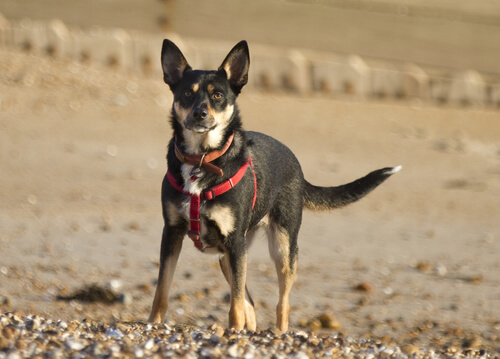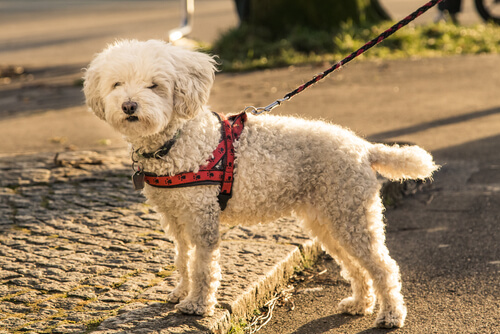Myths and Truths about Dog Harnesses

Dog harnesses are becoming the go-to option for taking dogs out on walks. However, there are still quite a few myths and misinformation regarding this tool, which we will analyze and debunk in this article.
Just like many other special items for pets, there are lots of different types of harnesses on the market. Personal preferences and price are the factors that affect a person’s purchase the most, leading them to decide on buying a certain brand or design. Despite that, many people hesitate to use dog harnesses because of the myths surrounding them.
1. Myth – The Dog Pulls More
Dog harness critics usually start out with this argument. The people presenting this argument are basing it on the fact that dogs that pull sleds wear a specific kind of harness. However, their behavior has nothing to do with what they’re wearing – it is not instinctive for pets to wear a harness and begin running and/or pulling things behind them.
In fact, it is necessary to teach dogs that pull sleds or participate in shooting sports to develop these talents. Gaining strength to pull something, or running in a straight line surrounded by other dogs is not one of the dog’s instincts.
A harness isn’t going to fix this behavior, meaning that, if a dog pulls on the leash when wearing a collar, he or she will also do it when wearing a harness. There are no magic solutions – in order for a dog to stop pulling on the leash, you simply have to teach him or her not to do so.
2. Myth – Harnesses are Not Painful
The use of a harness in front of the collar is defended, since the latter bothers and damages the dog’s neck. However, there are some type of harnesses for dogs that can be harmful. Not all of them support the dog’s weight and bone structure, and can badly hurt the animal in various ways if the harness is misused.

Front harnesses, also called anti-pulls, can cause injuries, such as contractures or dislocations. They are a great example that not all types of harness for dogs are harmless, since their long-term use ends up causing pain.
You should not consider using muzzle-type harnesses at all. These types of devices consist of nylon strips that are placed on the animal’s head and nose – the strap holds it under the jaw. In reality, it is a collar that causes serious damage and pain ever since first wearing one, and they are not at all recommended.
3. Myth – It’s Easier for the Dog to Escape
Many owners worried about their dog are afraid to put a harness on him or her, since they consider it easier to escape from than a collar. These people usually opt for collars with movable elements that prevent the dog from escaping by squeezing its neck, like martingales or choke chains.

There are special anti-escape harnesses on the market that were created for these very situations – they are the so-called ‘three-points’. These harnesses include an extra grip strip that goes around the dog’s belly, where he or she is thinnest. This way, no matter how much the dog recoils and tries to take it off, he or she cannot get the strip off their chest and therefore cannot escape.
4. Myth – Harnesses Are Too Expensive
In a similar manner as collars, beds or food bowls, there are a wide variety of prices on the market. Of course there are very expensive harnesses, but in reality, there is a very large price range from which you can choose.
There are dog harnesses for every budget. It is not necessary to buy a top brand, or a fashionable design, since these will always be the most expensive. The harness’s price tag should not be an excuse that keeps you from acquiring one.
5. Myth – They Are Difficult to Put On
While it is true that there are harnesses that are difficult to put on, this will depend on the design and the dog’s cooperation at the time of application. In this regard, we also have a choice – there are some harnesses that require more manipulation of the animal, and there are others that you simply attach to the dog, without the need to manipulate him or her.

For instance, there are certain models of dog harnesses that are a “Y” shape and require the dog’s cooperation in order to introduce its legs before being able to fasten it. However, there are other designs, such as Norwegian harnesses, where you introduce the animal’s head between two strips and nothing else is required.
Dog harnesses are the best option for having a quiet, safe walk with your furry friend. They are not difficult to put on; there are a wide variety of designs and prices available, and if you choose one that does not bother your pet, you will both come out on top. Before deciding on a harness, though, don’t be afraid to try different designs, colors and sizes. Your dog will thank you.
Dog harnesses are becoming the go-to option for taking dogs out on walks. However, there are still quite a few myths and misinformation regarding this tool, which we will analyze and debunk in this article.
Just like many other special items for pets, there are lots of different types of harnesses on the market. Personal preferences and price are the factors that affect a person’s purchase the most, leading them to decide on buying a certain brand or design. Despite that, many people hesitate to use dog harnesses because of the myths surrounding them.
1. Myth – The Dog Pulls More
Dog harness critics usually start out with this argument. The people presenting this argument are basing it on the fact that dogs that pull sleds wear a specific kind of harness. However, their behavior has nothing to do with what they’re wearing – it is not instinctive for pets to wear a harness and begin running and/or pulling things behind them.
In fact, it is necessary to teach dogs that pull sleds or participate in shooting sports to develop these talents. Gaining strength to pull something, or running in a straight line surrounded by other dogs is not one of the dog’s instincts.
A harness isn’t going to fix this behavior, meaning that, if a dog pulls on the leash when wearing a collar, he or she will also do it when wearing a harness. There are no magic solutions – in order for a dog to stop pulling on the leash, you simply have to teach him or her not to do so.
2. Myth – Harnesses are Not Painful
The use of a harness in front of the collar is defended, since the latter bothers and damages the dog’s neck. However, there are some type of harnesses for dogs that can be harmful. Not all of them support the dog’s weight and bone structure, and can badly hurt the animal in various ways if the harness is misused.

Front harnesses, also called anti-pulls, can cause injuries, such as contractures or dislocations. They are a great example that not all types of harness for dogs are harmless, since their long-term use ends up causing pain.
You should not consider using muzzle-type harnesses at all. These types of devices consist of nylon strips that are placed on the animal’s head and nose – the strap holds it under the jaw. In reality, it is a collar that causes serious damage and pain ever since first wearing one, and they are not at all recommended.
3. Myth – It’s Easier for the Dog to Escape
Many owners worried about their dog are afraid to put a harness on him or her, since they consider it easier to escape from than a collar. These people usually opt for collars with movable elements that prevent the dog from escaping by squeezing its neck, like martingales or choke chains.

There are special anti-escape harnesses on the market that were created for these very situations – they are the so-called ‘three-points’. These harnesses include an extra grip strip that goes around the dog’s belly, where he or she is thinnest. This way, no matter how much the dog recoils and tries to take it off, he or she cannot get the strip off their chest and therefore cannot escape.
4. Myth – Harnesses Are Too Expensive
In a similar manner as collars, beds or food bowls, there are a wide variety of prices on the market. Of course there are very expensive harnesses, but in reality, there is a very large price range from which you can choose.
There are dog harnesses for every budget. It is not necessary to buy a top brand, or a fashionable design, since these will always be the most expensive. The harness’s price tag should not be an excuse that keeps you from acquiring one.
5. Myth – They Are Difficult to Put On
While it is true that there are harnesses that are difficult to put on, this will depend on the design and the dog’s cooperation at the time of application. In this regard, we also have a choice – there are some harnesses that require more manipulation of the animal, and there are others that you simply attach to the dog, without the need to manipulate him or her.

For instance, there are certain models of dog harnesses that are a “Y” shape and require the dog’s cooperation in order to introduce its legs before being able to fasten it. However, there are other designs, such as Norwegian harnesses, where you introduce the animal’s head between two strips and nothing else is required.
Dog harnesses are the best option for having a quiet, safe walk with your furry friend. They are not difficult to put on; there are a wide variety of designs and prices available, and if you choose one that does not bother your pet, you will both come out on top. Before deciding on a harness, though, don’t be afraid to try different designs, colors and sizes. Your dog will thank you.
This text is provided for informational purposes only and does not replace consultation with a professional. If in doubt, consult your specialist.








